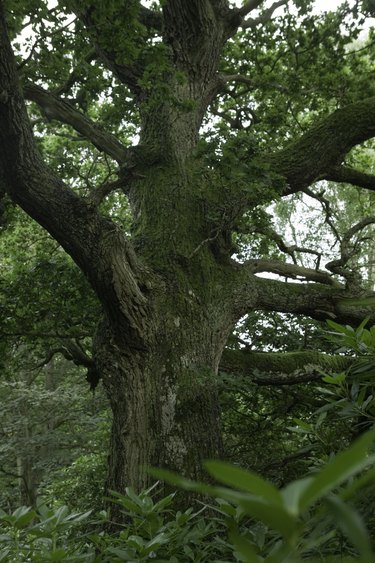
Galls on oak trees are deformities that occur on the twigs, branches and leaves, and are caused by small insect species. There are many types of gall infections on oak; however, most of the symptoms and treatments remain the same. While oak galls may appear as just abnormal growth, some infestations can cause severe injury to oak if left untreated. Early control methods are vital for reducing injury and cosmetic damage.
Causes
Video of the Day
Oak galls are small to large deformations on oak growth, caused by wasps, mites and small insects known as gall makers. Galls form when the insect releases chemicals into the tree in order to lay their young. The tree forms galls as a natural reaction to the gall makers' chemicals. The gall provides protein and natural protection for the developing insects larvae. The type of gall formed and the severity of the damage due to the abnormal growth depends on the species of insect infecting the tree.
Video of the Day
Types
Hundreds of insect pests of oak trees cause oak gall formations. Common types of galls on oak include: twig and stem galls, leaf galls, oak apple galls, roly poly galls, wool sower galls, vein pocket gall and leaf pocket gall and jumping oak gall. Most of these galls do not cause any harm to the infested oak. Twig and stem galls are the most serious threat to oak vitality. However, most other infections do not harm the tree, but cause an unsightly appearance.
Symptoms/Damage
Twig and stem galls such as the horned oak gal and gouty oak gall, can cause branch drop and girdling. Girdling reduces the infested branches ability to acquire nutrients and water from the main stem, which causes branch death. Twig and stem galls can grow up to 2 inches in diameter. Caused by a small wasp species, twig and stem galls are the most devastating gall infestation in oak. Oak apple galls are similar in size to the more harmful twig and stem galls. While the oak apple gall can grow to 2 inches in diameter, they rarely cause significant harm to the infested tree. Leaf galls cause small bubbles in leaves for the insect larvae to mature. However, the majority of gall infections cause little more than cosmetic damage to the infested oak.
Control
Chemical insecticides are rarely warranted for gall infections because the infections do not cause significant harm to the infected tree. Prune and burn infected branches and leaves to control oak galls. Pesticides can kill gall wasps before they infest oak. However, it is difficult and expensive to time proper insecticide treatment.